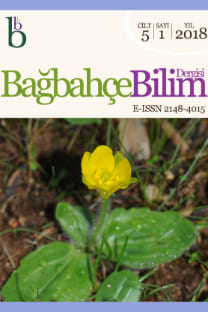Poskıllı ketentere [Camelina hispida Boiss. var. lasiocarpa (Boiss. & C.I.Blanche) Post (Brassicaceae)] taksonunun Türkiye’deki Varlığı ve Taksonomik Durumu
Bu çalışma ile Camelina hispida Boiss. var. lasiocarpa (Boiss. & C.I.Blanche) Post taksonuna ait Türkiye’den ilk örnek kaydı verilmiş, taksonomik durumu tartışılmış, bu taksona ait detaylı bir betim yapılmış ve üzerinde çalışılan örnekler INU herbaryumunda saklanmıştır.
Anahtar Kelimeler:
Malatya, Suriye, Türkiye, yeni kayıt
Leaf Micromorphogy of Cultivated Lettuce (Lactuca sativa L.) and its Wild Relatives
Cultivated lettuce (Lactuca sativa L.) is an economically important weedy plant for human consumption at worldwide. The primary gene pool of L. sativa consists of wild L. serriola L., L. aculeata Boiss. & Kotschy, L. azerbaijanica Rech. f., L. georgica Grossh. and L. scarioloides Boiss. while L. saligna L. is in its secondary gene pool. L. sativa has been subjected to various studies due to its economic importance. This study aims to reveal leaf micromorphology of the taxa in the primary and secondary gene pool of L. sativa and determinate these relationships based on leaf micromophological characters through phenetic analysis. In order to achieve these aims, character states of leaves belonging to the taxa were determined through multiple sampling and these data were subjected to analysis. According to the micromorphological data, L. saligna is the closest species to L. sativa and undulate anticlinal wall of epidermis cells is shared common character state for both taxa. The most variation was observed in density of epicuticular wax and wax type among the studied micromorphological characters. On the other hand the states of anticlinal and periclinal walls of epidermis cells are stable within the taxa. Indumentum on abaxial leaf surface is also stable within the taxa except L. saligna. In the light of these findings, anticlinal-periclinal walls of epidermis cells and indumentum can be used as distinctive characters to determine the boundaries between taxa in systematic studies in Lactuca.
Keywords:
Asteraceae, epidermis wall shape, lettuce gene pool, wax,
___
- Al-Shehbaz, I.A. ve Barriera, G. (2019). Typification of Edmond Boissier’s Cruciferae (Brassicaceae) names enumerated in Flora Orientalis. Boissiera 72.
- Boissier, P.H. (1867). Flora Orientalis 1:1017. H. Georg, Basel, Switzerland.
- Hedge, I.C. (1965). Camelina Crantz. Şu eserde: Davis P.H. (ed.) Flora of Turkey and the East Aegean Islands 1:490-493. Edinburgh University Press, Edinburgh.
- Koch, M.A., Kiefer, M., German, D.A., Al-Shehbaz, I.A., Franzke, A., Mummenhoff, K. ve Schmickl, R. (2012).
- BrassiBase: tools and biological resources to study characters and traits in the Brassicaceae version 1.1. Taxon 61(5): 1001–1009.
- Mutlu, B. (2012). Camelina Crantz. Şu eserde: Güner, A., Aslan, S., Ekim, T., Vural, M. ve Babaç, M.T. (edlr.) Türkiye Bitkileri Listesi (Damarlı Bitkiler) s. 263–264. Nezahat Gökyiğit Botanik Bahçesi ve Flora Araştırmaları Derneği Yayını, İstanbul.
- Parolly, G.,Yıldırımlı, Ş. ve Eren, Ö. (2007). Camelina hispida var. stiefelhagenii (Bornm.) Yıld. (Brassicaceae). Şu eserde: G. Parolly, Ö. Eren (ed.), “Contributions to the flora of Turkey, 2.”, 245-246.
- Willdenowia 37(1): 243-271. Post, G.E. (1896) Flora of Syria, Palestine and Sinai. Syrian s.88. Protestant College, Beirut.
- Turland, N. J., Wiersema, J. H., Barrie, F. R., Greuter, W., Hawksworth, D. L., Herendeen, P. S., Knapp, S., Kusber, W.-H., Li, D.-Z., Marhold, K., May, T. W., McNeill, J., Monro, A. M., Prado, J., Price, M. J. ve Smith, G. F. (edlr.). (2018). International Code of Nomenclature for algae, fungi, and plants (Shenzhen Code) adopted by the Nineteenth International Botanical Congress Shenzhen, China, July 2017. Regnum Vegetabile 159. Glashütten: Koeltz Botanical Books. doi: https://doi.org/10.12705/Code.2018.
- Yıldırımlı, Ş. (1998). A new combination and status, and typification for Camelina (Brassicaceae). Ot Sistematik Botanik Dergisi 5 (2): 1-4
- ISSN: 2148-4015
- Yayın Aralığı: Yılda 3 Sayı
- Başlangıç: 2014
- Yayıncı: Ali Nihat Gökyiğit Eğitim ve Sağlık Kültür Sanat ve Doğal Varlıkları Koruma Vakfı
Sayıdaki Diğer Makaleler
Osman TUGAY, Kuddisi ERTUĞRUL, Serdar ASLAN, Deniz ULUKUŞ
József Andrasovszky’nin (1889- 1943) 1911 Yılı Anadolu Botanik Gezisi
ÖMER ÇEÇEN, Zeki AYTAÇ, Hüseyin Mısırdalı, Ayvaz ÜNAL
EL Bayda –Lamluda (El Cebel EL Akdar /Libya ) Florası
Barış ÖZÜDOĞRU, HASAN YILDIRIM
EL Bayda-Lamluda (El Cebel EL Akdar /Libya ) Florası
Türkiye Florası İçin Yeni Bir Bitki Takson Kaydı: Zantedeschia aethiopica (L.) Spreng. (Araceae)
